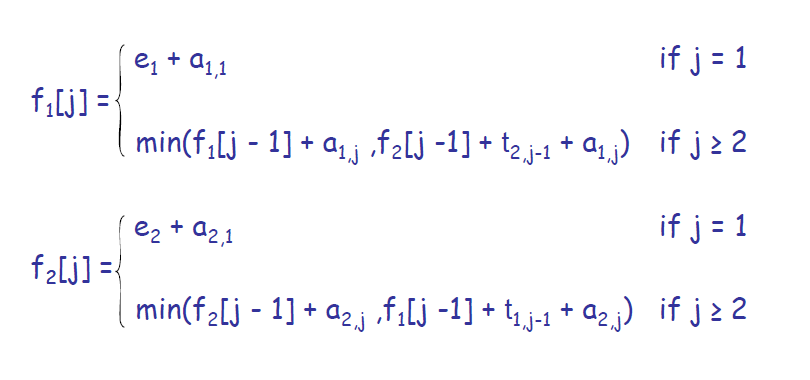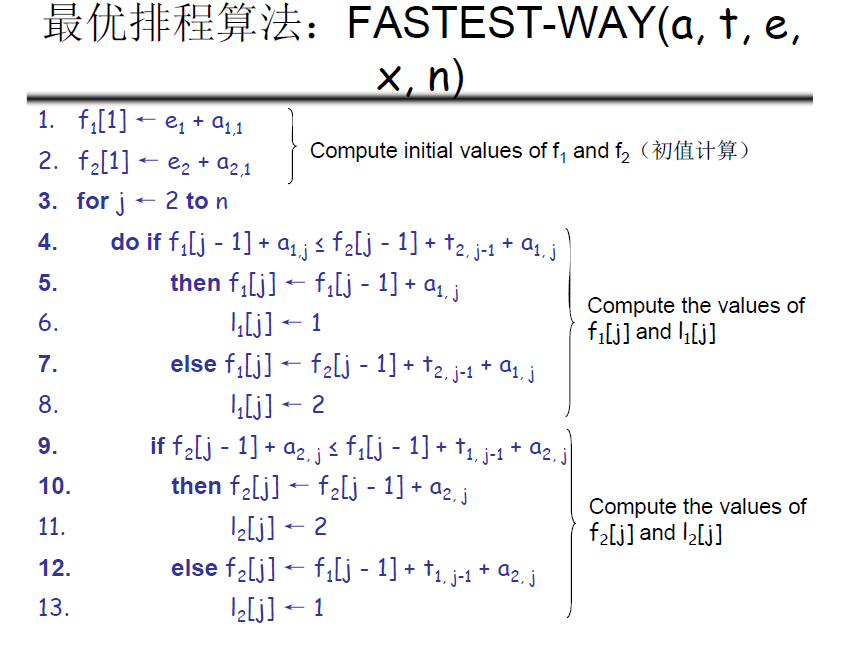Python 实现作业排程问题
1. 问题描述
- Automobile factory with two assembly lines
- Each line has n stations:
$S_{1, 1},...,S_{1, n}$and$S_{2, 1},...,S_{2, n}$ - Corresponding stations
$S_{1, j}$and$S_{2, j}$perform the same function but can take different amounts of time$a_{1, j}$and$a_{2, j}$ - Entry times
$e_1$and$e_2$and exit times$x_1$and$x_2$
- Each line has n stations:

给出一个示例的装配线,要求输出最优的排程方案

2. 思路分析
首先, 利用动态规划思想找出递归关系, 这个是最重要的一步

这里的 $f_1[j]$ 表示在第一条装配线的第 j
个站台处理完之后所花费的最少的时间. $f_2[j]$ 也是同理.
然后, 根据这个关系, 我们就可以自底向上构建 $f_1$ 和
$f_2$ 这两个数组了.
伪码描述如下

3. 代码实现
# 最优排程问题
def fastest_way(a:list, t:list, e:list, x:list, n:int) -> list:
'''
解决最优排程问题
:param a: 两条线上各自的每个站点的各自处理时间
:param t: 两条线上各自的每个前 n - 1 个站点的切换时间
:param e: 两条线的各自的 entry 时间
:param x: 两条线的各自的 exit 时间
:param n: 每条线的工作站的数目
:return: 最优时间, 路径和最后一个走过的工作站点
'''
# 两条线上每个站的处理时间
a1, a2 = a # 自动解包
# 两条线在第 i 个站换线需要的时间
t1, t2 = t
# 两条线上 e 和 x 的数值
e1, e2 = e
x1, x2 = x
# 两条线在每个装配点所花费的最小时间表(动态规划)
f1 = [0 for i in range(n)]
f2 = [0 for i in range(n)]
route = [[0 for i in range(n)], [0 for i in range(n)]] # 存储路径
time = float('inf') # 最优时间
final_line = 0 # 最后一个节点所在的线路
# 初始化
f1[0] = e1 + a1[0]
route[0][0] = 1 # 1 表示走第一条线路
f2[0] = e2 + a2[0]
route[1][0] = 2 # 2 表示走第二条线路
for i in range(1, n):
if f1[i - 1] + a1[i] < f2[i - 1] + t2[i - 1] + a1[i]:
f1[i] = f1[i - 1] + a1[i]
route[0][i] = 1
else:
f1[i] = f2[i - 1] + t2[i - 1] + a1[i]
route[0][i] = 2
if f2[i - 1] + a2[i] < f1[i - 1] + t1[i - 1] + a2[i]:
f2[i] = f2[i - 1] + a2[i]
route[1][i] = 2
else:
f2[i] = f1[i - 1] + t1[i - 1] + a2[i]
route[1][i] = 1
if (f1[n - 1] + x1 < f2[n - 1] + x2):
time = f1[n - 1] + x1
final_line = 1
else:
time = f2[n - 1] + x2
final_line = 2
return [time, route, final_line]
def print_route(i:int, j:int, route:list, n:int):
'''
递归打印装配的线路图
:param i: 装配线, 0 represents the first assembly line, 1 represents the second line
:param j: 当前节点
:param route: 存储两条线路的节点的父节点的 list
:param n: 装配线的节点数
:return: None
'''
if j == 1:
print('[Line: ' + str(i) + ' Station: ' + str(j) + ']', end=' ')
else:
print_route(route[i - 1][j - 1], j - 1, route, n)
print('[Line: ' + str(i) + ' Station: ' + str(j) + ']', end=' ')
if j != n:
print('=>', end=' ')
else:
print()
if __name__ == '__main__':
n = 5 # 每条线工作站的数目
# 两条线上每个站的处理时间
a1 = [7, 9, 3, 4, 8]
a2 = [8, 5, 6, 4, 5]
# 两条线在第 i 个站换线需要的时间
t1 = [2, 3, 1, 3]
t2 = [2, 1, 2, 2]
# 两条线上 e 和 x 的数值
e1 = 2
e2 = 4
x1 = 3
x2 = 6
a = [a1, a2]
t = [t1, t2]
e = [e1, e2]
x = [x1, x2]
res = fastest_way(a, t, e, x, n)
time, route, final_line = res
print('The shortest time:', time)
print('The best assembly line is: ', end='')
print_route(final_line, 5, route, n)
输出
The shortest time: 35
The best assembly line is: [Line: 1 Station: 1] => [Line: 2 Station: 2] => [Line: 1 Station: 3] => [Line: 1 Station: 4] => [Line: 1 Station: 5]
Python 实现作业排程问题
http://fanyfull.github.io/2021/05/26/Python-实现作业排程问题/